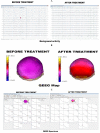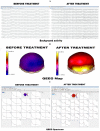Identification and reduction of retained primitive reflexes by sensory stimulation in autism spectrum disorder: effects on qEEG networks and cognitive functions
- PMID: 38154865
- PMCID: PMC10759118
- DOI: 10.1136/bcr-2023-255285
Identification and reduction of retained primitive reflexes by sensory stimulation in autism spectrum disorder: effects on qEEG networks and cognitive functions
Abstract
Several authors have reported finding retained primitive reflexes (RPRs) in individuals with autism spectrum disorders (ASD). This case report describes the reduction of RPRs and changes in cognitive function after transcutaneous electrical nerve stimulation (TENS) of muscle. Three individuals were examined in a study at the Institute for Neurology and Neurosurgery in Havana, Cuba. Two child neurologists, not involved in the study, conducted clinical examinations on each participant and diagnosed each with ASD based on DSM-V criteria and the Autism Diagnostic Interview-Revised (an autism evaluation tool). Each child with ASD possessed a triad of impairments in three domains: social interaction, communication, and repetitive behaviour. Individuals were evaluated by quantitative electroencephalographic measures and tested by standardised cognitive function tests before and after 12 weeks of intervention. These interventions were associated with reduced ASD symptoms in the three domains, significant changes in qEEG network connectivity and significantly improved performance on standardised cognitive tests.
Keywords: Child and adolescent psychiatry; Child and adolescent psychiatry (paediatrics); Clinical neurophysiology; Developmental paediatrocs.
© BMJ Publishing Group Limited 2023. Re-use permitted under CC BY-NC. No commercial re-use. See rights and permissions. Published by BMJ.
Conflict of interest statement
Competing interests: None declared.
Figures



Similar articles
-
The Relationship between Retained Primitive Reflexes and Hemispheric Connectivity in Autism Spectrum Disorders.Brain Sci. 2023 Jul 30;13(8):1147. doi: 10.3390/brainsci13081147. Brain Sci. 2023. PMID: 37626503 Free PMC article.
-
[Sensory-psychomotor evaluation in Autism: A new tool for functional diagnosis].Encephale. 2019 Sep;45(4):312-319. doi: 10.1016/j.encep.2018.12.003. Epub 2019 Mar 26. Encephale. 2019. PMID: 30922517 French.
-
Sensitivity and specificity of DSM-5 diagnostic criteria for autism spectrum disorder in a child and adolescent sample.Rev Psiquiatr Salud Ment (Engl Ed). 2021 Oct-Dec;14(4):202-211. doi: 10.1016/j.rpsmen.2019.10.005. Epub 2021 Nov 19. Rev Psiquiatr Salud Ment (Engl Ed). 2021. PMID: 34802987
-
Diagnostic tests for autism spectrum disorder (ASD) in preschool children.Cochrane Database Syst Rev. 2018 Jul 24;7(7):CD009044. doi: 10.1002/14651858.CD009044.pub2. Cochrane Database Syst Rev. 2018. PMID: 30075057 Free PMC article. Review.
-
Recent advances in autism research as reflected in DSM-5 criteria for autism spectrum disorder.Annu Rev Clin Psychol. 2015;11:53-70. doi: 10.1146/annurev-clinpsy-032814-112745. Epub 2015 Jan 2. Annu Rev Clin Psychol. 2015. PMID: 25581244 Review.
Cited by
-
The Relationship between Retained Primitive Reflexes and Hemispheric Connectivity in Autism Spectrum Disorders.Brain Sci. 2023 Jul 30;13(8):1147. doi: 10.3390/brainsci13081147. Brain Sci. 2023. PMID: 37626503 Free PMC article.
-
Detailed Analysis of the Palmomental Reflex and Its Clinical Significance.Brain Behav. 2024 Nov;14(11):e70164. doi: 10.1002/brb3.70164. Brain Behav. 2024. PMID: 39576271 Free PMC article. Review.
References
-
- Melillo R, Leisman G. Neurobehavioral disorders of childhood: an evolutionary perspective. New York, NY: Springer, 2010. 10.1007/978-1-4419-1231-2 - DOI
